Cosmin Laslau / Research Editor / Lux Research
The world looks to be underway towards a dramatic energy transition, as it shifts towards more renewables and a sophisticated digitized grid. It is tempting to think of the battle as already decided: Renewable deployments – driven primarily by solar and wind energy – are growing rapidly, albeit from a small base; costs are falling; policy is directionally favorable. However, new research based on big data analysis indicates a worrying trend – innovation interest in renewables is declining, after peaking about four years ago, as shown in the figure below. Without continued innovation momentum, long-term success driven by further clean energy technology improvements is thrown into question.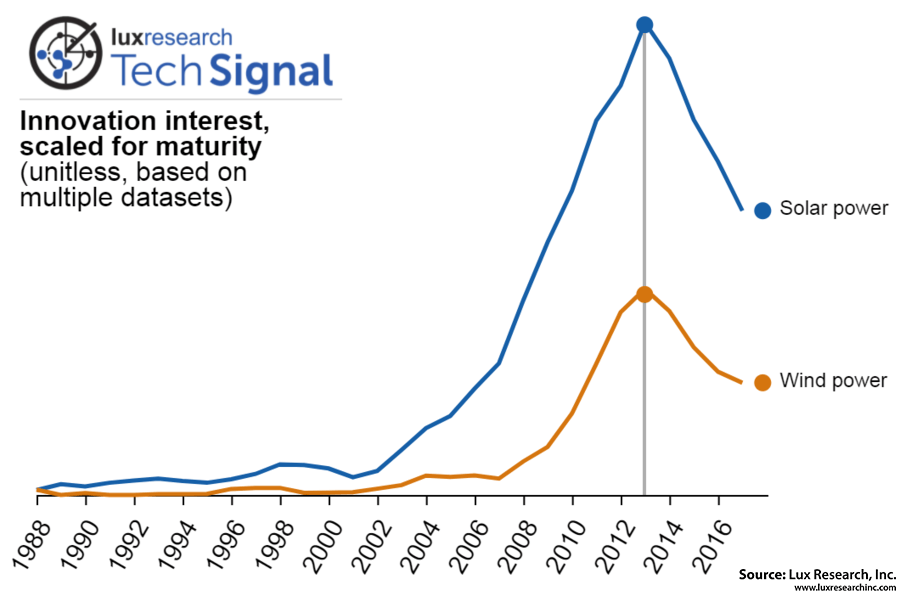
For context, the Lux Tech Signal works by algorithmically doing high-throughput parallel analysis of various large and complex datasets about innovation, resulting in a revealing picture about any technology’s progress. Full details on the Lux Tech Signal methodology can be found here (client registration required), including why the data is unitless and how it is scaled.
We have previously shown this methodology’s success in uncovering predictive data about emerging innovation like artificial intelligence, health sensors, and other digital transformation topics, as well as tracking declining innovation like diesel engines and the rise of tight oil, electric vehicles, and quinoa, to give just a few examples. Although the clean energy data above does not paint an encouraging picture for renewable generation innovation interest, what about energy storage? That is, maybe the innovation is on the integration side instead, for storing the renewable energy in batteries for later use? As the data below shows, looking at energy storage (including lithium-ion batteries) does shift the picture slightly, in that the peak is then around 2014 rather than 2013, but the direction of the trend remains the same: Plummeting interest in further widespread innovation.
It must be said that the above figures have focused on solar and wind energy, the big drivers in renewable deployments thus far. There are, of course, additional options. However, layering on other areas of innovation – like tidal power and geothermal energy – does nothing to shift the picture, as shown in the accompanying figure.
There are, admittedly, some that do less poorly; energy harvesting continues to spark interest, although its innovation trajectory is still relatively flat compared to non-energy topics like digital transformation. And there are undoubtedly hotspots of activity within these larger topics that are seeing some growth from a small base, which we will explore in a separate, future analysis on next-generation power.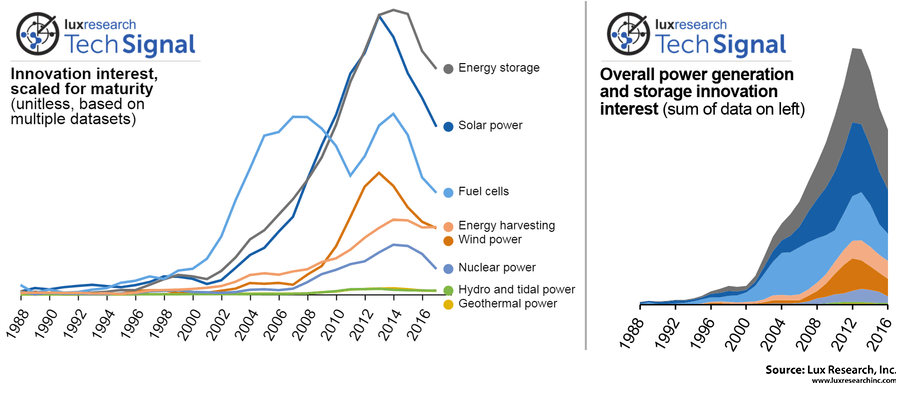
If, on the whole, we see a downward trend, then what does it mean that innovation interest is declining in clean energy – is that bad? There are two main schools of thought. The first interpretation is that the hard work has already been done in terms of technology development, and that solar, wind, and other renewables have reached a good enough status to eventually become the world’s main power sources.
According to this theory, what remains are incremental improvements, business model work, and scale-up investment. If that is the case, then companies that are actively innovating in renewable energy breakthroughs need to pull back, because they are trying to solve a problem that has already been addressed. That is one interpretation of the data’s peak above, but we caution that it is a dangerous and complacent one: Given the extremely high costs of solar plus storage systems today, to take one example, it seems unlikely that incremental improvements will be sufficient.
The second interpretation is that the world has an alarming innovation gap when it comes to renewables: We are experiencing a lull in creativity and commitment, but still need further breakthroughs to enable a true transition to a future grid that is largely driven by renewables. In this school of thought, the data above points to an opportunity for risk-taking, visionary companies to push through to the next level of renewable energy technology, with all of the potential benefits in terms of cost-savings, resiliency, and other advantages.
So, which of the two above theories is right? Data seems to support the second theory, albeit with a twist: We do not see strong innovation interest in physical clean energy technologies. Instead, the past few years have shown an uptick for digital technologies, like renewables production forecasting, utility customer analytics, and distributed energy resource management, as shown in the figure below. (Note that these three topics are just a diverse selection from the dozens of different technologies that our analysts on the Future Grid and Next Generation Power teams cover, and were selected as representative examples.)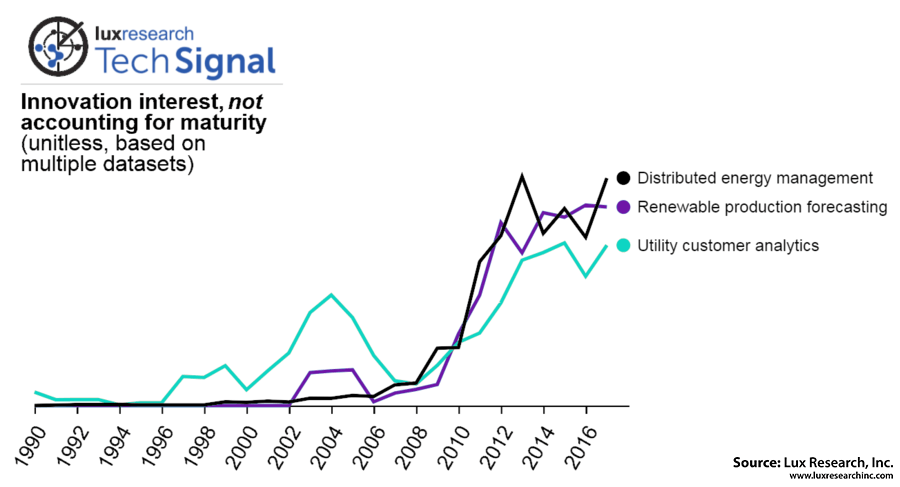
Digging further into the data, we see how the rise of these technologies has already been acted upon by some leaders – both large energy incumbents as well as newer or smaller specialists and start-ups. As the figure below shows, within these three areas of potential growth in the future of energy, firms such as ABB and General Electric are already moving to secure valuable intellectual property, talent, and market position. In the image below, a selection of some of the most active players in these areas of future grid innovation is shown, along with their relative innovation interest (scaled according to the circle size that their logo is placed in).
While innovation interest in these emerging technologies is growing steadily, it is still early days: Data analysis (not shown here) indicates a massive gap between the built-up knowledge around physical clean energy technologies, which have been in development for decades, and the more nascent state of these digital energy innovations. For companies interested in these future grid technologies, there is a lot of room for innovation, but also a lot of work to do.
Download the Spotting and Evaluating Innovation Sooner with the Lux Tech Signal case study to uncover the details and methodology of findings that could benefit your company today!
Filed Under: Uncategorized

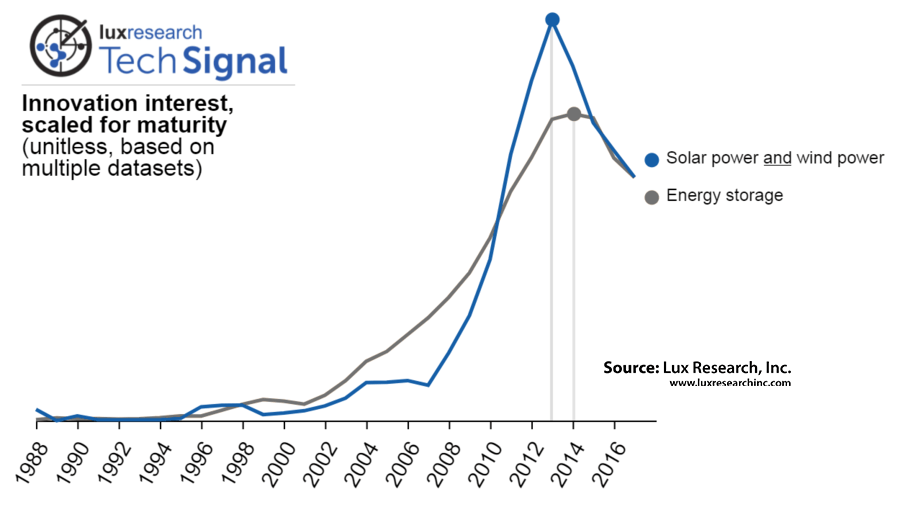
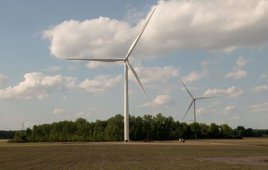



This might be interesting if it weren’t already being done by Totaro & Associates. Duplication with lesser accuracy is unfortunate.